Five Dynasties & Song (907 ∼ 1279 AD)

With the collapse of the Tang Dynasty, China was ruled by a series of short-lived dynasties originating from Kaifeng. Besides the five major dynasties, the country also split off several independent states.
- Later Liang 907∼923 AD
- Later Tang 923∼936 AD
- Later Jin 936∼946 AD
- Later Han 947∼950 AD
- Later Zhou 950∼960 AD
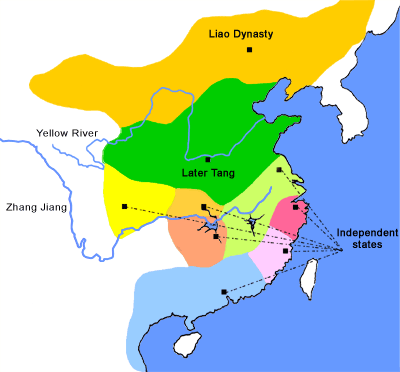
Northern and Southern Song Dynasties 960 ∼ 1279 AD
- Northern Song 960∼1127 AD
- Southern Song 1127∼1279 AD
About the Song Dynasties
Zhao Kuangyin reunified China and founded the Song Dynasty in 960 AD. The empire was continually threatened on all sides by invasion from barbarians. Besides problems in the north with the Liao Dynasty, the Song also had to contend with the Tibetans and the Tanguts tribe to the west. Eventually, the threat of invasion became a reality and the Jurchen (an isolated clan originating from the Tanguts tribe) established the Jin Dynasty in the north in 1127 AD. This forced the Song south into Hangzhou where they would remain until the late thirteenth century when the Mongols invaded China.
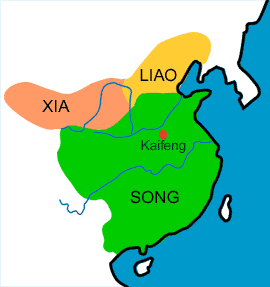
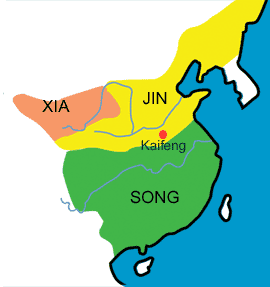
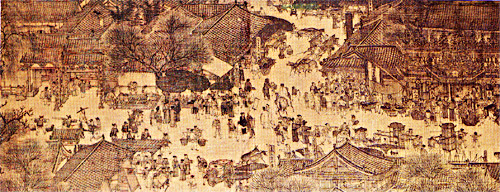
Fueled by economic growth from agriculture, an urban bourgeois class emerged. The bourgeois indulged in comforts of daily life and lived extravagantly. Marine trade expanded significantly due to both an increase in commercial trade and the growing difficulty of making overland trips because of the barbarian control of trade routes. Confucianism saw resurgence in this period and was later renamed neo-Confucianism by philosophers. Other new philosophies evolved and were also applied to medicine. The period was further buffeted by a series of reforms and counter-reforms. The "new laws" of the dynasty introduced by Wang Anshi (1021∼1086 AD), a prime minister in Northern Song, are held to have constituted radical political changes in China. The changes facilitated medical reorganization and enabled new healthcare systems or facilities to be set up, these included government dispensaries, hospitals, and charitable institutions.
Publishing Boom of Chinese Medicine Texts
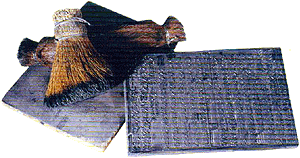
The use of woodblock printing, although existent since the Tang Dynasty in 868 AD, was further improved by Bi Sheng in 1040 AD with the invention of movable type. This had a significant impact on Chinese medicine and science in general as it enabled important texts to be more easily published and readily disseminated.
During this period, a state institution known as the "Bureau for the Re-editing of Medical Books," was created in order to "collect, collate and verify all medical texts bequeathed by 1,000 years of history." This bureau published several of the established classics and many books were rewritten or revised under new titles. Therefore many classics like Yellow Emperor’s Classic of Internal Medicine , Shen Nong’s Classic of Herbal Medicine, Pulse Classic (mai jing), and The ABC of Acupuncture and Moxibustion etc, have been handed down after being checked and printed. The bureau also produced commentaries on classics such as Yellow Emperor's Classic of Internal Medicine and Zhang Zhongjing's Treatise on Cold-induced and Miscellaneous Diseases.
In addition, many medical texts were published under government supervision or individually. Campaigns were launched by the Song government for gathering information from the public and for the periodic compilation of medical texts. A great deal of original material in the form of pharmacopoeias were written. Some important pharmacopoeial texts include:
- 973 AD, Ma Zhi along with others finished Herbal Medicine of the Kaibao Era (kai bao ben cao) , this herbal expanded the number of drugs to 983 and modified their classification.
- 1057 AD, Su Song and colleagues finished Complete and Annotated Materia Medica of the Jiayou Era (jia you bu zhu ben cao), the number of drugs was increased to 1,083.
- 1061 AD, Su Song and colleagues finished Illustrated Materia Medica (tu jing ben cao), this was the first time illustrations were included in a pharmacopoeia.
- 1108 AD, Tang Shenwei finished Classified Materia Medica (zheng lei ben cao), a unique pharmacopoeia listing 1,558 drugs with illustrations, it remained the model for the next 500 years.
- 1116 AD, Kou Zongshi finished Development of Herbal Medicine (yan yi ben cao), the book clarified the properties and pharmacology of herbs.
Besides pharmacopoeias, many prescription books were also published. The first one, entitled Imperial Benevolence Formulary of the Taiping Era (tai ping sheng hui fang), was commissioned by the government and written by Wang Huaiyin at the end of the tenth century. It lists a total of 16,834 prescriptions and gives details of the prescription, drugs used, syndromes and pathology. Other notable prescription texts written during this time are:
- 1107∼1110 AD, Chen Shiwen and Pei Zongyuan finished Formulary of the Taiping Welfare Dispensary Bureau (tai ping hui min he ji ju fang). This work lists 788 prescriptions and gives information on how to prepare and use drugs. It represents the first government-published prescription book in the world.
- 1111∼1117 AD, Cao Zongxiao and other medical officers finished General Catalogue of Divine Assistance (sheng ji zong lu). This book lists 20,000 prescriptions and describes the causes, symptoms and cures for different illnesses.
- 1253 AD, Prescriptions for Saving Life (yan yong he ji shen fang); this was an individually published text, in which the decoction known as gui pi tang is still used today.
The number and variety of such works testify to the flourishing state of Chinese medicine at the time.
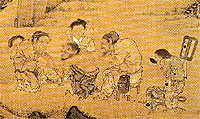
Medical Education
During the Song Dynasty, medical administrative duties and medical education were separated. The government's "Board of Medical Officers" was in charge of overseeing the practice of medicine and the delivery of medical care. Wang Anshi (1021∼1086 AD) an important political figure of the eleventh century initiated sweeping reforms that included developing a more perfect examination system and curriculum in medicine. As a result of his reforms, the Imperial Medical Bureau (tai yi ju), which was in charge of medical education, expanded to become the Imperial Medical College. Soon after, a number of medical schools were founded in different cities or towns in China and this extended medical knowledge to a more popular level.
Examinations for medical students were also launched during this period and were set up along similar lines to those for civil servants. Students were promoted to the next level based on their scholastic records and their treatment success rate. The Imperial Medical College was further divided into nine departments:
|
Besides studying the earlier classics of the Tang Dynasty, medical students would have newly created curricula, such as the "three causes" (san yin) theory by Chen Yan (see below "A new teaching" section), added by the end of the twelfth century. Students also became more familiar with anatomy as illustrations drawn by the physician/poet Yang Jie from autopsies of executed prisoners became available during (1102~1063 AD).

Another advancement in medical education was the casting of two life-size male bronze statues by Wang Weiyi (987∼1067 AD), an officer of the medical board, appointed to summarize the acupuncture classics for teaching acupuncture.

These statues had 657 acupuncture points drilled into them which were filled with water and covered with wax. When a student needled the acupuncture point correctly, water would leak out.
To complement the statues, Wang Weiyi compiled a book called Illustrated Manual of the Bronze Man Showing Acupuncture and Moxibustion Points (tong ren shu xue zhen jiu tu jing). This work was considered so important that it was carved on two stone steles and these were erected in Kaifeng, the capital of the Northern Song Dynasty, for public use. The bronze statues would contribute significantly to the standardization and future development of acupuncture.
A New Teaching: Theory on the Three Causes
As mentioned, a new approach to etiology was first propounded by the twelfth century physician, Chen Yan. His work Treatise on Three Causes of Diseases with Syndromes and Remedies (san yin ji yi bing zheng fang lun) stated that there are three types of pathogenic agents: endogenous, exogenous, and those that are neither one nor the other. These influences lead to an imbalance between the yin and yang in the body, between the vital energy (qi) and the blood, or impair functions of organs and meridians, all of which give rise to illness. This principle has been applied by traditional Chinese medicine physicians until today. The classification of pathogenic agents are:
- Endogenous agents include joy, anger, vexation, sadness, distress, fear and fright Primarily, which refer to the feelings or psychological influences on the mind.
- Exogenous agents include wind, cold, heat, humidity, drought and fire, which are seasonal influences or climatic variations of nature.
- Neither of above two include intemperance, fatigue, trauma and presence of parasites in the body. This group includes all types of chance mishap.
Medical Advances in Forensic Medicine
 Collected Records of Medical Jurisprudence (xi yuan ji lu) was written by Song Ci in 1247 AD. The book details how to perform autopsies and lists observations about physiology, histology, pathology, pharmacology, and toxicology. According to this book, someone who has been fatally poisoned will present with a green or purplish complexion, the eyes and mouth will be wide open, the nails on the hands and feet will be blue, and blood may trickle from the eyes, mouth, ears, and nose. To confirm that poisoning has taken place, a silver needle that has been scrubbed in soapy water should be stuck into the victim's mouth. If the needle turns a blackish color that cannot be washed off, then poisoning is confirmed. This book helped establish the beginning of forensic medicine in China and would go on to be an important medical work that was translated into at least five different European languages.
Collected Records of Medical Jurisprudence (xi yuan ji lu) was written by Song Ci in 1247 AD. The book details how to perform autopsies and lists observations about physiology, histology, pathology, pharmacology, and toxicology. According to this book, someone who has been fatally poisoned will present with a green or purplish complexion, the eyes and mouth will be wide open, the nails on the hands and feet will be blue, and blood may trickle from the eyes, mouth, ears, and nose. To confirm that poisoning has taken place, a silver needle that has been scrubbed in soapy water should be stuck into the victim's mouth. If the needle turns a blackish color that cannot be washed off, then poisoning is confirmed. This book helped establish the beginning of forensic medicine in China and would go on to be an important medical work that was translated into at least five different European languages. 
Pediatricians and Gynecologists
During the Song dynasty, the interest in medicine shown by the Song authorities led not only to official support for the publication of general medical works but also to a new surge in medical studies. Pediatrics and gynecology became a specialized and independent branch of medicine, and obtained significant results.
The most important figure in pediatrics was Qian Yi (1035∼1117 AD). His work was recorded by his disciple Yan Yizhong in the Key to Differentiation and Treatment of Children's Diseases (xiao er yao zheng zhi jue). Certain medications from this treatise have been preserved to the present, such as the decoction of Cimicifuga foetida and Pueraria lobata prescribed by Qian Yi for the treatment of smallpox and which traditional Chinese medicine continues to recommend for the treatment of measles. Moreover, Qian Yi contributed to a better understanding of eruptive fevers, such as smallpox, chickenpox, and measles, in terms both of symptoms and therapies. It dealt entirely with infant medicine, considered under its physiological, pathological and therapeutic aspects.
Other famous pediatricians or texts of the period are:
- 1150 AD, Liu Fang finished New Work on Children (you you xin shu), which encompassed the sum of contemporary medical knowledge concerning infant illnesses.
- 1156 AD, published by Imperial Bureau of Medicine, the xiao er wei sheng zong wei lun fang was one of the most important treatises on pediatrics during that time.
- 1260 AD, Yang Shiying finished ren zhai xiao er fang lun, which was an inventory of childhood illnesses.
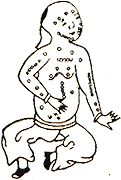 The Song Dynasty had developed public welfare in the urban areas with the opening of dispensaries, hospitals, and orphanages. Urbanization obliged the authorities to make special arrangement for public hygiene. In some places during the Southern Song period, road-sweepers and night-soil collectors were a daily presence. Evidence also points to the use of spittoons. Preventive measures against contagious diseases were set up by the government. The common occurrence of smallpox at that time, the cause of a very high infant mortality rate, stimulated studies in the disease. Studies in smallpox during the Song Dynasty:
The Song Dynasty had developed public welfare in the urban areas with the opening of dispensaries, hospitals, and orphanages. Urbanization obliged the authorities to make special arrangement for public hygiene. In some places during the Southern Song period, road-sweepers and night-soil collectors were a daily presence. Evidence also points to the use of spittoons. Preventive measures against contagious diseases were set up by the government. The common occurrence of smallpox at that time, the cause of a very high infant mortality rate, stimulated studies in the disease. Studies in smallpox during the Song Dynasty:- 1093 AD, Dong Ji finished xiao er ban zhen bei ji fang lun, which was the first published work in China on smallpox.
- 1241 AD, Chen Wenzhong finished xiao er dou zhen fang lun. A study of smallpox among children.
The fields of gynecology and obstetrics had begun to take on the hallmarks of an independent branch of medicine. produced a work, The Complete Book of Efficacious Prescriptions for Women (fu ren da quan liang fang), which specifically dealt with various gynecological problems associated with menstruation, pregnancy, and childbirth. A whole chapter of his book is devoted to cases of dystocia (difficult childbirth) and several examples are described: shoulder-, face-, and breech-delivery. Another famous gynecological work was by Yang Zijian, in 1098 AD he published the Ten Kinds of Difficult Childbirth (shi chan lun). The earliest text mentions the version method, a manual procedure to turn the child so as to facilitate delivery.
Foreign Influences
Due to the remarkable expansion in marine trade, exchange of information between East and West reached a peak at this time. There are records that Arabian merchants shipped over 60 different items of materia medica to European, Asian, and African countries. Included amongst these were cinnabar, ginseng, monkshood, pepper, tuckahoe (Indian bread), and bezoar. Bezoar was regarded as the most valuable and was held important at that time for the prevention of epidemics. The relationship that China enjoyed between the tenth and twelfth centuries with Korea, Japan, South-east Asia, and the Arab world facilitated mutual exchanges in the fields of medicine and pharmacy. Among the items of tribute offered by various states to the Chinese emperor, it is common to find animal, vegetable and mineral products that were to be used in the manufacture of medicine. Such were rhinoceros horn, ivory, rose-water, pearls, coral, and melons. In return, many medical classics or physicians were sent to these states and this greatly influenced their medical development. Nowadays, copies of many ancient classics which have been lost in China can still be found elsewhere in the world.



